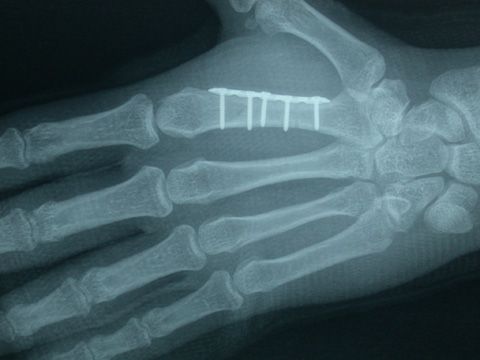HAND FRACTURES
The hand has a support structure which forms from many bones and allows complex functions. Muscles that provide finger and wrist movements are tied to some parts of this support structure. Fractures due to excess forces on bones may form. When the fracture occurs, some compliant arise such as pain, swelling, bruising, deformity, using disability of the damaged region. As fractures may be not disintegrated, they may be disintegrated to form multiple and deformed. Some fractures are on the body of the bone and some of them extends from end part of the bone into the joint. Treatment of the fractures that reach into the joint is more difficult. Joint movement limitation occurs in general. Fragmental fractures occur after high energy traumas in general. Infection risk is present in fractures together with open injury.
Usually the disease is diagnosed after patient examination and X-ray imaging. As hand has a complex structures, experience is important in fracture evaluation. Computerized tomographic examination may be performed in detection of treatment method in some fractures.
It may be used for treatment of fractures that brace or plaster do not dislocated. Some fractures are fixed with wires by taking the ends face to face under scopy imaging which allows us to make radiological examinations under anesthesia.
If open injury is present for fractures that can not be taken face to face, the skin is opened and parts are taken face to face. The fracture is fixed by using plaque, screw and wires. (Figures 1-2-3)



If the fracture extends to the joint surface, the joint surface should be carefully corrected and fixed. If the fracture is excessively fragmental or bone defect is present, bone parts taken from other parts of the body may be placed in the fractured area. Elbow and hip may be used as bone graft. Taking bone graft doesn't give permanent damage to patients; undesired situation is rarely seen except inflammation and recovery problems that may occur after every surgery.
If the lesion is contaminated and the fracture is fragmental, the fracture is fixed with bars (external fixator) which are applied from outside of the body on pins that is applied to bone from upper and lower level. In intraarticular multiple fractures, pins applied over the bar are alienated from each other and fracture parts to them may be taken close to the original place (ligamotaxis). Fracture knitting period varies according to the place and shape of the fracture. Joint movements after the fracture may be limited. Therefore, physical treatment should be started as soon as possible after the bone knitting is completed.








